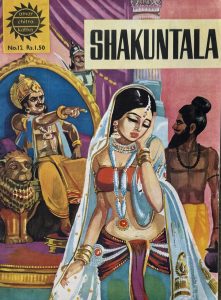
4156 - Shakuntala
Author: Amar Chitra Katha
Amar Chitra Katha’s "Shakuntala" retells the timeless love story from the Mahabharata, blending mythology, romance, and destiny into a beautifully illustrated comic. Story Overview - Shakuntala, the daughter of Sage Vishwamitra and the celestial nymph Menaka, is abandoned at birth and raised by Sage Kanva in a forest hermitage. - She grows into a graceful and kind-hearted woman, deeply connected to nature and the animals around her. - King Dushyanta encounters her during a hunting trip and is captivated by her beauty and wisdom. - They marry in a Gandharva ceremony (a mutual agreement without rituals), and Dushyanta gives her a ring as a token of love before returning to his kingdom.- Due to a curse, Dushyanta forgets Shakuntala, and she loses the ring that could prove their union. - Eventually, the ring is found, Dushyanta’s memory returns, and he reunites with Shakuntala and their son Bharata, who later becomes a legendary emperor—giving India its name, Bharat. Keywords: believer, hard-working Ideal For: Amar Chitra Katha’s Shakuntala is ideal for readers who want to explore Indian mythology through a visually engaging and emotionally resonant format. Here’s how it shines: Ideal For: - Young readers – Simplified storytelling and vivid illustrations make it accessible for children and early teens - Mythology enthusiasts – Offers a concise yet faithful retelling of a classic tale from the Mahabharata - Cultural education – Great for introducing Indian epics, values, and traditions in classrooms or at home - Fans of Kalidasa – A gateway to compare the comic version with the poetic drama Abhijnanashakuntalam - Collectors of Indian comics – A must-have for anyone building a library of Amar Chitra Katha titles - Bedtime storytelling – Its narrative style makes it perfect for reading aloud and sparking imagination It’s not just a comic—it’s a cultural artifact that bridges generations. Age: This book is for people that are 9-14 years old. Theme: Amar Chitra Katha’s Shakuntala centers around timeless themes of love, memory, identity, and destiny, all woven into a mythological narrative that’s both poignant and culturally rich. Central Themes: - Love and Separation – The romance between Shakuntala and King Dushyanta is tested by time, distance, and a curse that causes him to forget her. - Recognition and Truth – Shakuntala’s struggle to prove her identity and the truth of her relationship highlights the importance of inner strength and divine justice. - Divine Intervention – A celestial voice ultimately restores Dushyanta’s memory, reinforcing the idea that truth prevails with divine support. - Motherhood and Legacy – Shakuntala’s son, Bharata, becomes a legendary ruler, symbolizing the enduring impact of her courage and virtue. - Feminine Grace and Resilience – Shakuntala embodies dignity, patience, and emotional depth, making her a revered figure in Indian storytelling. This version beautifully simplifies the complex emotions and moral dilemmas of the original epic, making it accessible for younger readers while preserving its emotional weight. Tone: The tone of Amar Chitra Katha’s Shakuntala is a blend of romantic, emotional, and reverent storytelling, crafted to resonate with readers of all ages. Tone Breakdown: - Romantic and Poetic – The love story between Shakuntala and Dushyanta is portrayed with tenderness and idealism, echoing the lyrical quality of Kalidasa’s original drama. - Emotional and Dramatic – The narrative captures heartbreak, longing, and eventual reunion, evoking empathy and suspense. - Respectful and Mythological – The comic treats its source material—the Mahabharata—with reverence, highlighting divine elements and moral lessons. - Inspiring and Heroic – Shakuntala’s dignity and Bharata’s legacy are framed to inspire pride and admiration, especially for young readers. - Accessible and Engaging – The tone is simplified for clarity, with vibrant illustrations and dialogue that make the story approachable without losing its depth. It’s a tone that balances mythic grandeur with human vulnerability, making it both timeless and relatable. Book type: Myth, History, Comic Length: Usually short but about 20 pages.
